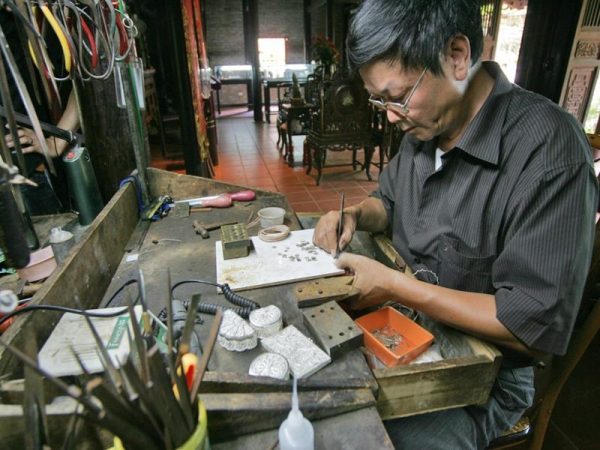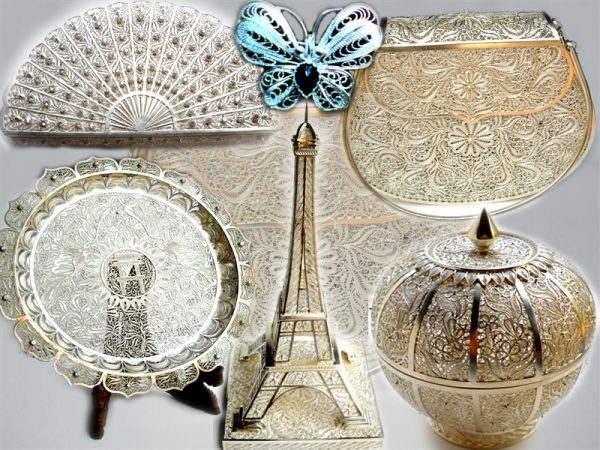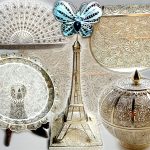“Yen Thai silk fabric, Bat Trang pottery, Dinh Cong goldsmith and Ngu Xa brazier” have been known as the quintessential quarters of the ancient Thang Long trade village. Dinh Cong village’s jewellery craft is one of the few ancient Thang Long crafts that have still existed today.
Dinh Cong village is located on To Lich riverbanks, now in Dinh Cong ward, Hoang Mai district. As historically recorded, Dinh Cong village is famous for gold and silver engraving. In the reign of King Ly Nam De, there were three Tran brothers named Tran Hoa, Tran Dien and Tran Dien living in the village. During the riots, they accidentally learned to make items from gold and silver. Since then, they had taught the craft to the villagers, making the reputation for Dinh Cong gold and silver products.

The worker makes the products more lively.
Compared to Dong Xam (Thai Binh) and Chau Khe (Hai Duong) silver products, the products in Dinh Cong village have their own characteristics. They are made completely manual, requiring high workmanship. The workers must know four basic techniques: smoothing, assembling, carving, and wire drawing. Smoothing is to make jewellery without carving but creating a smooth and glossy surface and a standard form. Assembling involves combining parts in a harmonious and balanced manner. Carving is to have jewellery surface with drawings, patterns and texture. Wire drawing is to draw melted silver into a thread, then into strands of hair to create patterns of birds, flowers, etc. attached to the jewellery. Each product is a strictly technical artwork with quintessential aesthetics and use.
In the early nineteenth century, 50-60% of Dinh Cong villager pursued jewellery craft. As the economy shifts from subsidy to the market mechanism, this number reduced to a few. Due to little income compared to that from other occupations, many families switched to easily earning work. Along Dinh Cong street, there are now no silver workshops, but shops and stores close together instead. Right in the birthplace of the jewellery craft, there are not many traditional craftsmen. With the passion and love for such ancient craft, two artisans in Dinh Cong ward, Quach Van Truong and Quach Van Hieu are still determined to keep this occupation alive. Artisan Quach Van Truong is now old and his youngest son, Quach Phan Tuan Tu, is his successor. His silver workshop is over 30m2, located next to the temple of Jewellery Trade Ancestor on Bui Xuong Trach Street. Every day, about 6 hardworking workers in the workshop create sophisticated silver products to serve customers’ needs.

Extremely sophisticated silver products
There have been so far five generation in the family of artisan Quach Van Hieu pursuing the silver craft. He started his apprenticeship at the age of 5, and when he was 15, he was the master of the family. According to him, to make silver products, it is necessary to use pure silver (silver 999 – also called silver 10) which is melt and then poured into a mould to form a small, long silver ingot. The next step is to draw such small silver ingot into a smaller and longer silver thread. Previously, this stage was a tough task because of using hands entirely. Yet, now it is divided into two sub-stages partially with mechanical support. Before drawing, a hammer is used to roughly rivet the silver ingot for easy operation. Next, it is drawn into threads. To do this, the worker must use a drawing ruler with small holes corresponding to each section from thick to thin. The silver threads are flattened in one end which is put into each hole. The worker then draws the thread through each hold until the smallest thickness is reached. Once the necessary thickness has been reached, the two silver thread are seamed together like a rope and pass through the machine to be flattened. From thin silver threads, small items are made and put together to form the product. Apart from conventional silver products such as rings and earrings, there are now a variety of sophisticated products that combine both traditional and modern elements. Some products like silver paintings take over a month to be completed.
Looking at the sophisticated silver products, you can see the persistence, intelligence and creativity of Vietnamese jewellers in general and Dinh Cong craftsmen in particular.
Mai Chi

